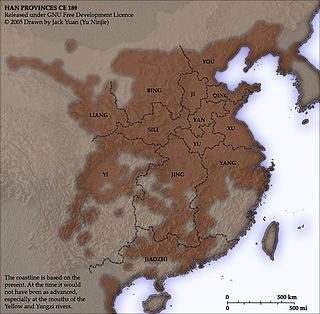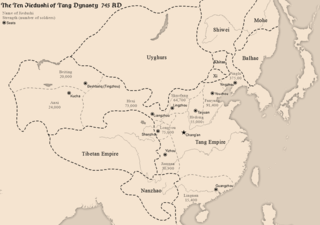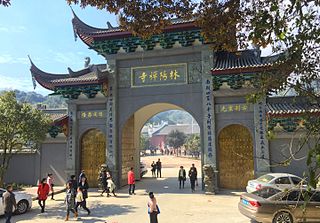
Fenghua (help·info) is a district of the city of Ningbo, Zhejiang Province, China. The district and its administrative hinterlands has a population of over 480,000.
The history of the administrative divisions of the Imperial China is quite complex. Across history, what is called 'China' has taken many shapes, and many political organizations. For various reasons, both the borders and names of political divisions have changed—sometimes to follow topography, sometimes to weaken former states by dividing them, and sometimes to realize a philosophical or historical ideal. For recent times, the number of recorded tiny changes is quite large; by contrast, the lack of clear, trustworthy data for ancient times forces historians and geographers to draw approximate borders for respective divisions. But thanks to imperial records and geographic descriptions, political divisions may often be redrawn with some precision. Natural changes, such as changes in a river's course, or loss of data, still make this issue difficult for ancient times.

Zhou were historical political divisions of China. Formally established during the Han dynasty, zhou exist continuously until the establishment of the Republic of China in 1912—a period of over 2000 years. Zhou were also previously used in Korea, Vietnam, and Japan .

The jiedushi were regional military governors in China during the Tang dynasty and the Five Dynasties and Ten Kingdoms period. The post of jiedushi has been translated as "military commissioner", "legate", or "regional commander". Originally introduced in 711 to counter external threats, the jiedushi were posts authorized with the supervision of a defense command often encompassing several prefectures, the ability to maintain their own armies, collect taxes and promote and appoint subordinates.

Hengyang is the second largest city of Hunan Province, China. It straddles the Xiang River about 160 km (99 mi) south of the provincial capital of Changsha. Its built-up, metro area consisting of 4 out of the 5 urban districts was home to 1,075,516 inhabitants at the 2010 census.
Duji was a circuit of the Chinese Táng Empire. It was established by Emperor Xuánzōng and covered today's Luòyáng and the area around it. Duji Circuit was succeeded by the Sòng Dynasty's Jingxibei Circuit. It contained three prefectures: Dōngdū (東都), Luòzhōu (洛州), and Rǔzhōu (汝州).

Longquan is a county-level city and former county under the administration of the prefecture-level city of Lishui in southwestern Zhejiang Province, China, located on the upper reaches of the Ou River and bordering Fujian province to the southwest.
Zhou Yue (周岳), courtesy name Junzhao (峻昭), was a warlord late in the Chinese dynasty Tang Dynasty, who controlled Wu'an Circuit from 886 to 893.

Tongguan is a subdistrict of Wangcheng district, Changsha, China. It is located on the eastern bank of Xiang river, the subdistrict is bordered by Dingziwan subdistrict to the south, Qiaoyi and Chating towns to the east and north, Jinggang town and Gaotangling subdistrict across the Xiang river to the west. Tongguan has an area of 90.3 km2 (34.9 sq mi) with a population of 50 thousand, its administrative centre is at Huacheng village. the subdistrict has 5 residential communities and 9 villages under its jurisdiction. Tongguan is located on the eastern bank of Xiangjiang River in the northern part of Wangcheng District. It has one provincial-level cultural relic protection unit, one municipal-level cultural relic protection unit, four county-level cultural relic protection unit and two county-level cultural relic site. Tongguan has been known as "Town of Ceramics" and "Ancient Tongguan Town".
The Taiping Huanyu Ji, or "Universal Geography of the Taiping Era [976-983]," is a 10th-century AD geographical treatise by Chinese scholar Yue Shi 樂史 (930-1007), written during the reign of Emperor Taizong of Song in the Northern Song Dynasty. Comprising 200 scrolls, it has entries for nearly all areas of China at the time of its publication, complete with place-names and their etymologies. The work generally follows Tang Dynasty systems of geographical and political designation, dividing China into 13 "Circuits", and then subdividing further into the more traditional "prefectures" and "counties". Because it is largely based on Tang works, it constitutes an important source for the study of Tang geography.
Jiangnan Circuit or Jiangnan Province was one of the major circuits during the Tang dynasty, Five Dynasties period, and early Song dynasty. During the Tang dynasty it was known as Jiangnan Dao (江南道), and during the Song dynasty Jiangnan Lu (江南路), but both dao and lu can be translated as "circuit". In 1020 it was divided into 2 circuits: Jiangnan East Circuit and Jiangnan West Circuit.
West Lingnan Circuit was a circuit of China during the Tang dynasty.
Deng Chuna, courtesy name Chongyun (沖韞), was a warlord in the late Tang dynasty China, who controlled Wu'an Circuit as its military governor (Jiedushi) from 893 to 894, when he was defeated and killed by Liu Jianfeng, who took over the circuit.

The Tang dynasty administered territory using a hierarchical system of three descending divisions: circuit dào (道), prefecture zhōu (州), and county xiàn (縣). Prefectures have been called jùn 郡 as well as zhōu 州 interchangeably throughout history, leading to cases of confusion, but in reality their political status was the same. The prefectures were furthered classified as either Upper Prefectures, Middle Prefectures, or Lower Prectures depending on population. An Upper Prefecture consisted of 40, 000 households and above, a Middle Precture 20, 000 households and above, and a Lower Prefecture anything below 20, 000 households. Some prefectures were further categorized as bulwark prefectures, grand prefectures, renowned prefectures, or key prefectures for strategic purposes. A superior prefecture was called a fu (府).
Hebei Circuit or Hebei Province was one of the major circuits during the Tang dynasty, Five Dynasties period, and early Song dynasty. During the Tang dynasty it was known as Hebei Dao (河北道), and during the Song dynasty Hebei Lu (河北路), but both dao and lu can be translated as "circuit". In 1042 it was divided into 2 circuits: Hebei East Circuit and Hebei West Circuit.

Linyang Temple is a Buddhist temple located in Jin'an District of Fuzhou, Fujian, China.

Langya Temple is a Buddhist temple located on Mount Langya (琅琊山), in Langya District of Chuzhou, Anhui, China.










